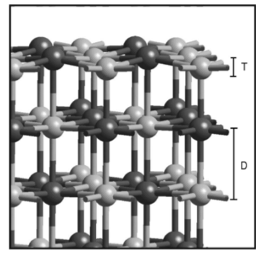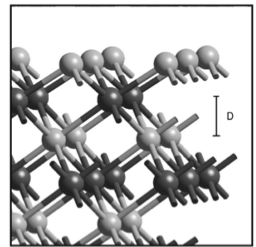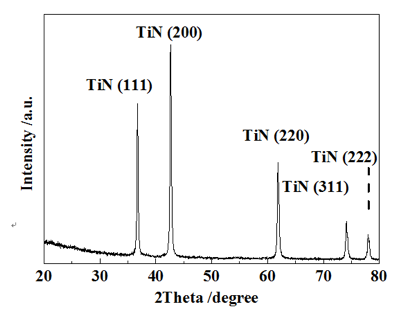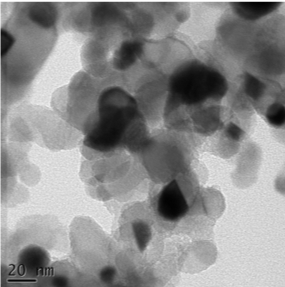-
Titanium Nitride
May 13, 2019 | ACS MATERIAL LLCTitanium nitride (TiN), an alternative plasmonic material to gold, possesses unique physiochemical properties most notable in plasmonic devices. A compatible material within biological environments and the semiconductor industry, TiN exhibits superior properties to noble metals such as high temperature durability, chemical stability, corrosion resistance, low cost and high mechanical hardness. TiN is widely used in microelectronics, biomedical devices and food-contact applications. It proceeds to sparking great interest in fields such as plasmonic photo-thermal therapy, solar/thermophotovoltaics, heat assisted magnetic recording and plasmon-mediated photocatalysis.
Introduction
Titanium nitride (TiN) belongs to a unique class of refractory metals where a nonmetallic element (N) forms a compound with a transition-metal element (Ti). The unusual combination of metal with nonmetal and interesting properties that ensue have challenged scientists to explain the nature of bonding in these materials. Two surface orientations of the refractory compound are of particular interest as follows. In the case of the <100> orientation, it has been found that when a plane contains two atomic species, in addition to the inward relaxation of the whole plane, titanium atoms recede below the surface slightly more than the nitrogen atoms as shown in Figure 1a below. In the case of the <111> orientation (Figure 1b) the N-terminated surface relaxes inwards more strongly than the Ti-terminated surface.1
a.

b.

Figure 1. a. <100> and b. <111> surfaces of TiN. Light colored spheres represent titanium atoms and dark colored spheres represent nitrogen atoms. T is plane width and D is the distance between atomic planes.1
The structure of the <100> and <110> oriented surfaces can be described using two parameters: T and D. Plane width, T, for planes that contain both Ti and N atoms is defined as the distance between the subplanes occupied by Ti and N atoms. The second parameter D represents the distance between the average positions of TiN planes parallel to the surface. These positions are defined as a mean value of the height of Ti and N subplanes. In the case of the <111> surface, the distance D is the actual, not the average, subplane distance, since the surface planes are occupied only with either titanium or nitrogen atoms and relaxations in the plane do not occur.
TiN is a metallic compound characterized by high melting point, ultra-hardness comparable to that of diamond, good electrical and thermal conductivity, and high resistance to corrosion.2 Due to its superior properties, TiN is widely used in various industrial applications. Its exceptional hardness and wear resistance enable the use of TiN as a high-performance coating material.
Synthesis
There are several methods that can be used to prepare titanium nitride. Some of them can be described as follows:
(1) The reaction of titanium metal powder with nitrogen gas to produce a pure TiN powder.3 Variations of this method include physical vapor deposition (PVD) by which titanium metal (or titanium compound) is vaporized either in a nitrogen plasma, by low-pressure sputtering or by electron beam evaporation under nitrogen, and deposited as a thin film of TiN on a substrate heated to 200-500°C. These PVD methods for producing thin films have been discussed by Vaidyanathan in further detail.4
(2) The reaction of titanium metal powder with sodium azide where the solid reactants are ignited in a nitrogen atmosphere and the sodium is volatilized during combustion.
(3) The reaction of titanium tetrachloride with a mixture of hydrogen and nitrogen or ammonia hydrogen5, used to deposit a thin coating by chemical vapor deposition (CVD) on a substrate heated to ˃1000°C.6
(4) The reaction of sodium titanate with sodium azide where the product materializes in the form of whiskers.7
(5) Carbothermal reduction of titanium oxide by means of heating with carbon powder in a nitrogen atmosphere.
a.

b.

Figure 2. a. XRD patterns and b. TEM image of TiN
Figure 2a shows the XRD patterns of TiN. The characteristic XRD peaks at 2θ of 36.6°, 42.6°, 61.8°, 74.1°, and 77.9° correspond to the <111>, <200>, <220>, <311> and <222> diffractions of TiN. Figure 2b shows a TEM image of TiN from our ACS Material lab where irregular structures can be seen with an average diameter of about 20 nm.
Applications
Over decades, TiN has been of interest as a refractory material in a variety of applications due to its physical properties, which have proven to be well suited for harsh environments. It is typically regarded as a hard material with a high melting point, good chemical durability and good conductivity. Among many other materials, TiN stands out by means of two important properties; bio-compatibility and compatibility with CMOS technology.8 It has been considered as a protective coating in high temperature environments for applications in supersonic jets,9 and harsh mechanical applications such as coating for milling tools.10
Furthermore, TiN provides refractory properties along with reasonably good plasmonic properties in the visible and near infrared ranges. This unique combination of material properties offers the potential to advance technologies such as plasmonic photo-thermal therapy, solar/thermophotovoltaics (S/TPV), heat assisted magnetic recording (HAMR), solar thermoelectric generators (STEG), plasmon-mediated photocatalysis, and plasmon assisted chemical vapor deposition.
Therapeutic Applications
Recently, lithographically fabricated TiN nanoparticles have been shown to provide dipolar resonances exactly in the desired range for therapeutic applications. Furthermore, it has been shown that TiN nanoparticles act more efficiently than Au nanoparticles of identical geometries when excited with 800 nm laser light.11 The resonance peak of TiN nanoparticles was also found to be more broad than that of Au nanoparticles. These results show that plasmonic TiN nanoparticles with a simple spherical shape and no size restrictions can be used for photothermal therapy. Furthermore, the fact that TiN is already being used successfully as a coating for biomedical implants and many other biological applications, makes it a very interesting alternative to Au nanostructures. Thus, production of colloidal plasmonic TiN nanoparticles with optimized optical properties remains an exciting and promissory research opportunity.
Solar/ Thermophotovoltaics
Due to its adjustable optical properties, TiN can be engineered for efficient collection of energy from the sun. With a melting point around 2900°C, TiN is certainly a very promising plasmonic material in this field. The strength of TiN nanostructures has been further tested and compared to Au by pulsing with a laser for 5 seconds at 550 nm. Initial results show both absorbers to have high absorbance, however, scanning electron microscope images after testing verifies that TiN nanostructures can stand against high intensity pulses where Au nanostructures fail. For nonlinear plasmonics, such durability under high intensity laser illumination is inherently a desired feature.12
Heat Assisted Magnetic Recording (HAMR)
Tip-based plasmonics13 is another broad application area where metallic nanoparticles such as TiN have been found useful. Apart from research applications such as near-field scanning optical microscopes (NSOM) or other local field enhanced signal measurements, some commercial applications like HAMR are also considered feasible. For long lifetime and reliability, the nanostructured near-field transducer must exhibit chemical stability and corrosion resistance14 making the search for alternative plasmonic materials inevitable for HAMR technology.15 TiN, known already to be corrosion resistant and durable at high temperatures, has shown its optical properties changing only slightly with increasing temperatures up to 375°C.16 In addition, we have seen that the optical performance of TiN nanoparticles is indeed comparable to identical Au nanoparticles in the near infrared region where diode laser technology is well established.17 Therefore, near-field transducer designs based on TiN nanostructures have the ability to propel HAMR technology forward and closer to real life products and applications.
Conclusion
TiN is a refractory compound with very interesting and widely versatile properties. Due to its biocompatible nature and excellent stability under harsh conditions, TiN has been widely used in microelectronics, biomedical devices and even food-contact applications. With continual research and testing, TiN continues to prove its extensive value in a wide variety of applications.
ACS Material Products:
FAQ
Q. What is the Formula for Titanium II nitride?
A. The chemical formula for Titanium (II) Nitride is Ti2n, which represents titanium in the +2 oxidation state. Additionally, the stable and widely used compounds in research and manufacturing industries are Titanium Nitride (TiN).
Q. What Is Titanium Nitride?
A. A golden-colored coating to improve the surface properties of other materials. Titanium nitride is a hard ceramic chemical compound of titanium and nitrogen. It combines metallic conductivity with corrosion resistance and extreme wear resistance.
Q. What Are Titanium Nitride Drill Bits Used for?
A. These drill bits are used for a wide range of materials like metals, aluminium, steel, stainless steel, and hard and soft woods as well. Despite this, it enhances surface hardness, improves durability, and reduces friction, allowing a bit to last longer.
Q. What Is Titanium Nitride Coating?
A. A durable, hard, and thin protective layer of titanium & nitrogen that is applied to different parts to improve the resistance to corrosion, friction, and wear. It is commonly applied by using a physical vapour deposition (PVD) process.
Q. What Is Titanium Nitride Used for?
A. TiN is primarily used for insanely hard, wear-resistant, and sometimes it is used as a gold-colored coating for components, tools, and medical implants. Moreover, it increases the performance and durability of applications like punches, dies, and cutting tools.
Q. What Is Black Titanium Nitride?
A. A modified form of TiN that appears black or dark, rather than gold, and it offers enhanced wear resistance and a sleek finish.
Q. How to Polish Titanium Nitride?
A. To polish TiN surfaces gently, you need the help of diamond pastes and fine abrasives to restore the shine without damaging the thin coating layers.
Q. How to Remove Titanium Nitride Coating?
A. You can remove the titanium nitride coating by using mechanical abrasion, plasma treatment, and acid etching. Professionals and researchers select the most suitable method based on the base material and coating thickness.
Q. Does Titanium Nitride Look Like Gold?
A. Yes, Tin can closely resemble gold due to its golden colour reflections. Therefore, it makes it a popular option for jewellery and decorative finishes.
Q. Is Titanium Nitride Coating Worth It?
A. Absolutely, TiN coatings extend life span, reduce wear, and provide high-performance hardness for consumer tools and industrial tools.
Q. How Strong Is Titanium Nitride?
A. TiN has a hardness between 1800-2100 HV and best mechanical stability at high temperature; therefore, it is considered extremely strong.
Q. Is Titanium Nitride Toxic?
A. No, TiN is non-toxic and it’s famous for its biocompatibility, which is why it becomes a preferable material for medical implants and coatings.
Q. Is Titanium More Rarer Than Gold?
A. No, gold is extremely rarer than titanium because titanium is the ninth most abundant element in the Earth’s crust. Gold is found at a rate of only four parts per billion in the Earth's crust.
References
1. M. Marlo, V. Milman, Physical review B, 2000, 62, 2899.
2. K. Schwarz, CRC Crit, Rev. Solid State Mater. Sci., 1987, 13, 211.
3. K. Agte, K. Moers, Z. Anorg. Allgem., Chem., 1931, 198, 233.
4. P . N . Vaidyanathan, Ceram. Engn. Sci. Proc., 1988, 9, 1209.
5. A. A. Barragan, N. V. Ilawe, L. L. Zhong, B. M. Wong, L. Mangolini, J. Phys. Chem. C 2017, 121, 2316.
6. G. K. Hyde, Biomed. Mater. 2009, 4, 025001.
7. H. O. Pierson, Handbook of Refractory Carbides & Nitrides: Properties, Characteristics, Processing and Apps, William Andrew, Incorporated, 1996.
8. U. Guler, Nano Lett. 2013, 13 , 6078.
9. N. T. Wakelyn, U. S. N. Aeronautics, S. Administration, Titanium Nitride: An Oxidizable Coating for the High-Temperature Protection of Graphite, National Aeronautics and Space Administration, 1961.
10. S. Zhang, W. Zhu, J. Mater. Process. Technol., 1993, 39, 165.
11. W. Li, Adv. Mater., 2014, http://dx.doi.org/10.1002/adma.201401874.
12. M. Kauranen, A.V. Zayats, Nat. Photon., 2012, 6, 737.
13. N. C. Lindquist, Laser Photon. Rev., 2013, 7, 453.
14. M. H. Kryder, Proc. IEEE 2008, 96, 1810.
15. N. Zhou, Nanophotonics, 2014, 3, 141.
16. S. Tripura Sundari, J. Appl. Phys., 2014, 115 , 033516.
17. U. Guler, Farad. Discuss., 2014, http://dx.doi.org/10.1039/C4FD00208C.